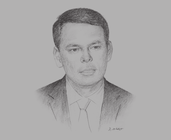Jaime Hernández Martínez, Director-General, Federal Electricity Commission: Interview

Interview: Jaime Hernández Martínez
To what extent can the restructuring of the public utility increase the flexibility, transparency and competitiveness of the energy sector?
JAIME HERNÁNDEZ MARTINEZ: Like many other public sector companies in the energy sector, the Federal Electricity Commission (Comisión Federal de Electricidad, CFE) is going through a significant transformation due to the reform started in 2013. In 2016 we faced the challenge of separating into transmission, distribution, supply and generation subsidiaries, with the aim of making the organisation open, accessible, competitive and attractive to investment. The restructuring process was long and complex, involving new advisory and administration boards for each subsidiary. These boards are key to making transparency the basis for each one of the new entities, as one of the cornerstones of energy reform is ensuring decisions are made in an open and coherent manner.
Another collective goal of these new CFE companies is to move away from expensive and contaminating sources of energy to greener, cleaner and cheaper options, which should increase the competitiveness of the electricity sector. The reform has also allowed us to be more flexible as a company when it comes to prioritising our own investments by allowing us to behave more like a private company; reducing our debt burden and investing in areas that are more profitable for us, thereby paying more dividends over the long term for the Mexican economy and population.
What does the expected rise in energy prices represent for consumers’ purchasing power?
HERNÁNDEZ: It is more important than ever to ensure we keep diversifying our portfolio towards greener, more sustainable and, in the long term, cheaper sources of energy. Until February 2017 there had not been an increase in domestic prices for 26 months, and if compared to industrial electrical prices in the US, today the difference is 84%. This is attractive and fundamental for the success of the Mexican industry, especially given the fact that prices are lower in real terms than in 2012. One goal of the reform is to change the structure of the country’s energy system to make it more dynamic and efficient. But, most importantly, it aims to attract private capital in order to make us less reliant on the 20th-century model of fossil fuels and, instead, become a more dynamic 21st-century power market. This should ultimately result in lower energy prices for the end user.
How can the implementation of the energy reform generate much-needed investment and capacity for power generation?
HERNÁNDEZ: A critical part of the reform is modernising the CFE’s power plants by introducing updated technology. We have implemented ambitious plans to bring natural gas to all states by providing a new era of more competitive electricity generation, while simultaneously delivering much needed energy supplies to underdeveloped parts of the country. In the case of generation, our biggest challenge is to bring private capital to invest in building capacity and efficiency, whereas in transmission the challenge is to continue implementing measures to prevent transmission loss.
In 2014 we lost around 16% of our energy through transmission and now we are looking to reduce this loss by around 1.5% per year, and finished 2016 on a transmission loss of only 12%. The total investment in the whole transformation process lies at around MXN260bn ($15.7bn) across different parts of the company, of which MXN160bn ($9.6bn) is to be spent on the renovation of infrastructure and the implementation of new technology. MXN40bn ($2.4bn) will be provided for transmission and MXN50bn ($3bn) will go towards public and private investments. For instance, the FIBRA E investment vehicle is a critical instrument for the dynamism of the industry. It is already seen as a crucial way to attract investment in transmission and distribution, because it provides solid returns for private investors and leads to a robust electricity network.
You have reached the limit of premium articles you can view for free.
Choose from the options below to purchase print or digital editions of our Reports. You can also purchase a website subscription giving you unlimited access to all of our Reports online for 12 months.
If you have already purchased this Report or have a website subscription, please login to continue.

